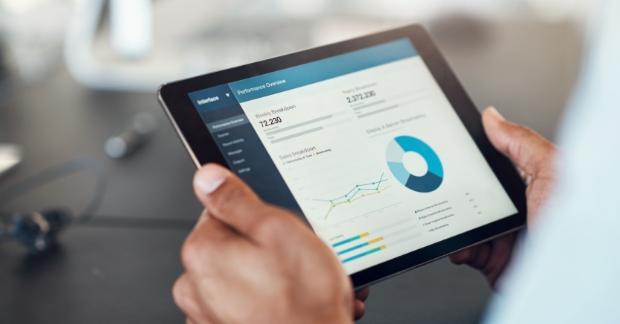Lauded as the new era of marketing, programmatic advertising has emerged in recent years as the premier way to automate the buying and selling of online advertising.
But tech marketers have been slow to jump on this trend. Only 20% of our recent paid digital advertising survey respondents are doing programmatic advertising, though another 40% are interested in getting started.
If you know how to leverage it, programmatic advertising can be a great help to tech companies of any size. And if you don’t know how, that’s okay too! That’s what we’re here for. Read on to learn more about what programmatic advertising is and how to use it.
So, what exactly is programmatic advertising?
Programmatic advertising is the use of algorithmic software to purchase digital advertising space. In other words, it’s an automated bidding system for buying ad impressions on a variety of websites and apps beyond just Google.
Programmatic advertising uses traffic data and online display targeting to evaluate users and predict which ads to which they’d respond best. Examples of such data include behavior🎭 data, cookie🍪 data and demographic👨👨👦 data.
To “do” programmatic advertising, however, you will need a paid subscription to a “demand side platform” or DSP…and buckle up because it’ll be costly. It’s not uncommon for this type of software to have minimum monthly ad spends of $20K or more!
That said, DSPs allow you to bid ads of all types (e.g., native, banners, video, etc.) AND optimize the performance of these ads based on helpful KPIs like effective cost per clicks (eCPC) and effective cost per miles (eCPM).
So for the power paid advertising user, this can be a great investment.
How does programmatic advertising differ from traditional PPC?
While PPC has many formats, let’s be honest…most people just assume it’s the classic text ads on the first page of Google. (In fact, according to our recent survey, 93% of tech marketers are using this tactic.)
In that case, you create ads and place bids within Google’s platform for display only on Google’s search engine or within Google’s partner network of sites.

The problem? If Google doesn’t have a relationship with a particular website, your ad won’t appear there. 😱
The Google Display Network reaches 2,000,000 websites, which is a small droplet in the worldwide bucket of nearly two billion websites! Programmatic advertising enables tech marketers to reach these websites not covered by the Google Display Network. 😅
When programmatic advertising first entered the scene, the “big boys” in the PPC game (aka Google, Facebook, etc.) did not play nicely with this new technology. They claimed their own algorithm did the same sort of bidding and targeting, so they wouldn’t let DSPs run ads on their properties.
More recently, however, things have changed. You can now use a DSP to run your ads on Google and Facebook, as well as other networks.
What types of programmatic advertising are available to tech marketers?
Tech marketers may use any of four main types of programmatic advertising:
Real-time bidding (RTB)
Also sometimes called open marketplace, open auction or programmatic direct, RTB is arguably the most popular type of programmatic advertising. With this type of programmatic advertising, you can bid on open ad slots on specific publisher websites in real time.
RTB follows a specific format called second-price auctioning. At a second-price auction, you don’t have to pay your bid amount to secure the slot. Instead, the highest bidder is charged just $0.01 more than the second-highest bidder. In turn, the second-highest bidder is charged slightly more than the third-highest bidder, and so on and so forth.
While it’s easy to set up and use RTB, it does present a drawback—even though the system tells tech marketers the general category of the publishers whose spots they can bid on, they don’t tell you exactly who the publishers are.🤷🏽♀️ So, you have no way of knowing where exactly your ads will appear after you’ve bid on them.
Private marketplace (PMP)
The PMP works similarly to RTB, but it’s performed in a closed-auction format, which means that you can only bid if you receive an invite to the event. 👑
PMPs are typically an event during which select marketers have the opportunity to bid on premium ad inventory not available on the general market. In fact, many demand-side platforms (DSPs) host their own PMPs designed for exclusive access by their users/customers.
Marketers in a PMP are also privy to which website slots they’re bidding for, so they can better determine their ads’ real ROI. Because of their scale, PMPs are most beneficial for tech companies with a mass reach.
Preferred deals
Preferred deals offer advertisers the opportunity to select the ad inventory at a fixed price before it goes to PMPs and then open auctions.
Before proceeding with a preferred deal, publishers and marketers have to negotiate and agree on points like targeting, pricing, etc.🤝🏾 Once they’ve done that, the publishers send bidders an advanced look at their ad inventory. Bidders aren’t required to make any purchases in order to see the inventory.
Making preferred deals, also known as the process of spot buying, is a great option for tech markers who want to work with DSPs to better understand their audience and which ad impressions would best drive conversions.
Programmatic direct
Finally, this type of programmatic advertising, sometimes called programmatic guaranteed or automated guaranteed, is more like typical buying. Programmatic direct facilitates the buying and selling of ad space one-on-one, instead of via bidding.
To reach a deal, the buyer and seller negotiate a price directly. Once they’ve reached that agreement, the seller immediately sells the ad space to the buyer.
Programmatic direct also lets tech marketers filter their ad space search, allowing you to specify important details for their search, such as ad inventory, audience targeting, prices and frequency capping.
It offers the most potential ROI boost to companies that already know exactly where they want to place their ads and have the budget to do so.
Is programmatic advertising worth it for B2B tech?
Programmatic advertising offers tech marketers a variety of key advantages over traditional paid advertising, such as:
- Higher impressions at scale
- Better ROIs
- More time to focus on ad improvement and optimization
- Access to advanced ad targeting features
- Access to first-party data
Also, did you know that with programmatic advertising, you can access over 80 additional inventory sources AND you can bid on site placements that are otherwise inaccessible?
Okay, I’m convinced…now how should a tech company choose a DSP?
Programmatic advertising sounds great! Now how do you actually go about accessing and implementing it?
Well, as we mentioned before, you can’t do it on your own. Some of the top DSPs out there for mobile, in-app, display ads (and more) include:
- HUAWEI Ads
- Remerge
- Smadex
- MAAS
- Adikteev
- AdColony
- Jammp
- Hitapps
- Bidease
- InMobi
- Entravision
- Splicky
- SmartyAds
- Basis
- AdRoll
Before you get started with any one programmatic advertising software system, consider the following factors:
Reach
When considering reach, i.e. the audience you can reach, look at DSP inventory, connections and available data.
Inventory
Generally speaking, the best DSPs are those that offer a diverse inventory (access to video, mobile and tablet placements). If you can tap into all of these ads types, you can reach a wider audience.
Connections
When considering reach, we also recommend you look for a DSP with high quality connections to which you can gain access by partnering with them. Depending on your goals, you may even want to look for one with access to global traffic. So, when you’re shopping around, be sure to ask them about their traffic sources.
Available data
The more relevant data to which a DSP has access, the better you can optimize your RTB campaigns, the better optimized the campaign, the greater your reach to a relevant target audience.
Platform efficiency
Make sure your potential programmatic ad platform is easy to navigate, set up and manage. Your goal is to choose DSP technology that straightforward and intelligent, not complicated. Complicated and complex systems can slow down the buying process and waste your time and resources.
The better choice is a DSP committed to constantly and improving its technology’s targeting options, bidding methods and overall functionality (e.g. always increasing the accuracy of real-time reporting).
Cost model
This is the one people always want to talk about—money and fees. A standard DSP includes in its service fee within your CPM bid. However, some companies like to sneak in a hidden fee, so pay attention to that.
You can also expect a request for a monthly or annual spend, or a service contract. We recommend that, if you come across this, you make sure to find out and document what percentage of these fees are going towards ad exchange and platform maintenance. This way, you can do a better job of avoiding overspending in the long term.
Likewise, find out what the DSP’s minimum fee is so that you accurately budget for the future.
Support
Finally, always go for a platform that offers good support. You want to be able to turn to them to help you with technical issues, as well as tasks like setting up your first ad campaign with them.
PS: Some platforms have a limit to how much free support they offer, so check that out too.
This is just the beginning with programmatic advertising. The possibilities of where it may take your ROI are vast. Now that you’re all caught up, what excites YOU about implementing programmatic advertising? 🤔






